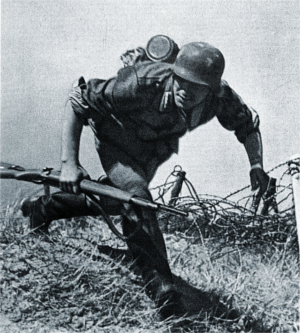Quoting Janusz Gumkowkski and Kazimierz Leszczynski’s Poland Under Nazi Occupation:
In its first raids on Polish towns, the Luftwaffe had bombed residential areas without any delusion that they were military objectives. Any idea that perhaps these were mistakes was dispelled by the dropping of fragmentation and incendiary bombs on small suburban settlements and on hospitals and hospital trains clearly marked with red crosses on their roofs.
Halik Kochanski’s The Eagle Unbowed: Poland and the Poles in the Second World War, page 62:
Wieluń, a farming town 60 miles east of Breslau, had the dubious honour of becoming the first town in Poland to be flattened by [Fascist] bombs. The hospital, school, churches and shops were all bombed and over 1,600 people, 10 per cent of the town’s population, were killed on the first day of the war. […] Ryszard Zolski, working in an ambulance unit, witnessed hospitals, ambulances and ambulance trains being bombed despite being marked prominently with a red cross.
Richard C. Lukas’s Did the Children Cry?: Hitler’s War Against Jewish and Polish Children, 1939–1945, page 208:
Only a fraction of the sick and injured Polish children could receive medical care because there were no more than 6,000 physicians in the entire country. For the 90,000 children in Warsaw after the war, there was only one hospital with 50 beds; the [Fascists] had destroyed all the other children’s hospitals.
Many Soviet hospitals likewise went unspared. Jonathan Trigg’s The Defeat of the Luftwaffe: The Eastern Front 1941–45, A Strategy for Disaster:
At a field hospital near Smolensk, the medical orderly Very Yukina described the horrific scenes: ‘The enemy’s planes were bombing our military formations at will […] more and more wounded began arriving at the hospital […] We tried to evacuate some of them to hospitals further from the front, but although the trains were marked with the Red Cross the [Axis] methodically bombed them.’⁶¹
(Emphasis added in all cases. Of course, the Axis had other ways of destroying medical facilities.)
Christopher Hale’s Hitler’s Foreign Executioners:
Hospitals too offered Himmler’s SS warriors special opportunities to wreak havoc. At Wolski Hospital, [Fascist] troops fanned out through the wards, shooting some of the sick and injured where they lay. Anyone who could walk or run they drove onto a nearby railway viaduct where a machine gun had been set up. The Wolksi was burnt to the ground. Many other hospitals suffered the same dreadful fate. Just one escaped destruction. This was where Dr. Dirlewanger set up a temporary headquarters.
[…]
In the neighbouring western suburb of Ochota, Bach‐Zelewski unleashed the RONA or Kaminsky Brigade. Commanded by SS‐Brigadeführer Bronislav Kaminsky, these wild‐eyed, habitually intoxicated young Russian [traitors] attacked city hospitals with as much relish as Dirlewanger’s thugs. […] When the RONA men tired of this sport, they corralled any surviving patients and staff in the hospital garden. As the RONA men raced through the hospital setting it ablaze, SS men began firing wildly into the defenceless crowd of hospital workers and patients.
(Emphasis added.)
There were other examples of the Luftwaffe destroying hospitals in, for example, Britain, but Poland was the first subject that came to mind, followed by the Soviet Union.
Short post today, but to tell you the truth I don’t feel up to discussing something more complicated.
Click here for events that happened today (October 19).
1935: The League of Nations placed some ineffectual economic sanctions on Fascist Italy for its invasion of Ethiopia.
1937: Fascist Italy raised taxes significantly in an effort to meet the cost of increased arms production and maintaining its colonies.
1939: Hermann Göring created the Haupttreuhandstelle Ost to co‐ordinate the confiscation of Jewish and Polish assets in Fascist‐occupied Poland.
1940: Axis submarines U‐38, U‐46, U‐47, and two others attacked Allied convoy HX‐79 two hundred miles west of Ireland, sinking five ships and damaging tanker Shirak. Additionally, Axis submarines U‐99, U‐100, U‐101, and U‐123 continued to attack Allied convoy SC‐7 one hundred miles northwest of Ireland. U‐123 sank Allied ship Shekatika as Shekatika received her fifth torpedo hit. U‐99 sank Norwegian ship Snefjeld (but the entire crew survived).
1941: The Axis defeated the Soviet forces within the Vyazma pocket in Russia and captured 670,000 men, 1,000 tanks, and 4,000 artillery pieces. The Axis also began rounding up men over the age of 16 in the Serbian town of Kragujevac in Yugoslavia. (Of the 2,324 gathered, about 300 of them were students from the First Boys High School.) Axis submarine U‐204 sank Allied tanker Inverlee southwest of Tangier at 0300 hours; 22 were died, 21 lived. In the same region, Axis submarine U‐206 sank Allied ship Baron Kelvin at 0614 hours; 26 were died, 16 lived.
1942: The Axis transferred the last twelve surviving Jewish prisoners of Flossenbürg to Auschwitz. Coincidentally, the Axis and its collaborators exterminated one hundred eighty Jews in Manzhinsk.
1943: Allied aircraft assaulted and sunk cargo vessel Sinfra at Crete, and two thousand and ninety‐eight Italian prisoners of war drowned with it.
1944: The Fascist bourgeoisie ordered the complete and total destruction of Warsaw, but the Wehrmacht evacuated Belgrade as Walter Stettner von Grabenhofen lost his life Yugoslavian partisans in Montenegro. The Axis’s 4.Armee withdrew from around Tilsit, East Prussia, and Feldmarschal Model called off the attempts to relieve Aachen. Lastly, Takijiro Onishi met with the senior staff officers of the 201st Kokutai at Mabalacat airfield north of Manila, Philippine Islands, and asked for volunteers to form a special attack unit.


Amazing work you’ve done on this community, I’ve been particularly startled just how much information I was lacking on this subject. The discussion of capitalism in decay will never stop being interesting to me thanks to you.